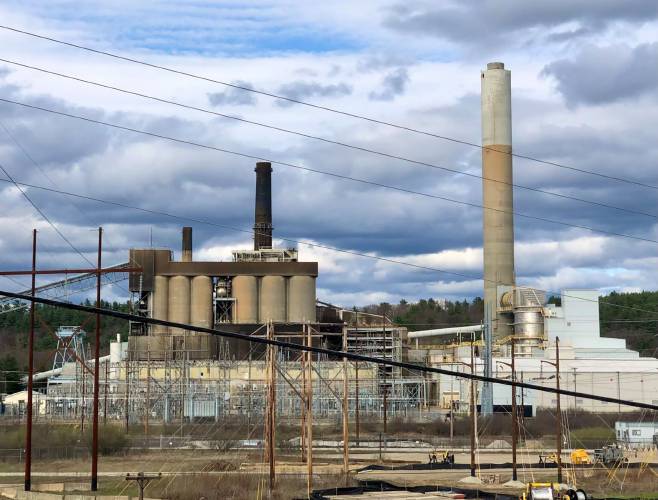Opinion: Due diligence in developing clean energy projects

Merrimack Station in Bow, N.H., is the last active coal plant remaining in New England. Hadley Barndollar/ New Hampshire Bulletin
| Published: 02-10-2024 6:30 AM |
Jim Hadley lives in Northwood.
Recently, the New Hampshire House, Science, and Technology Committee held a public hearing on a bill (HB 1623) that would slow the clean energy transition in the state. As a former state energy official in both New Hampshire and Massachusetts, I submitted testimony, opposing it and offered the following:
According to the U.S. Energy Information Agency (EIA), the pace of the green energy transition has accelerated significantly in recent years. Figures released at the end of 2023 show roughly 40% of U.S. electricity production is now emission-free. With growing concern that climate change is accelerating, rapidly decarbonizing power generation is more important than ever. With a massive build-out of solar power underway in other New England states and across the country, New Hampshire’s energy policymakers continue to drag their heels in its shift toward green energy.
Almost as important as the rise in emission-free power is the significant drop in coal, the dirtiest form of fossil fuel generation. In 2022, coal provided nearly 20% of the country’s power, but in 2023, it was down to 16.2% (a 19% drop). That’s a precipitous decline and means that wind and solar combined now account for roughly the same amount of coal generation. These latest figures from the EIA clearly show that renewables are ascendant and coal is on the decline. Their forecasts suggest that momentum is building and green energy is likely to have another banner year in 2024.
The number of coal plant closures and planned for decommissioning in the U.S. are widespread. The 173 coal-fired units closing between now and 2030 are located in 33 states. And another 55 units with announced closure dates between 2031 and 2040 are spread across 17 states. These closures also reflect the aging of the U.S. coal fleet.
Last year the Bow coal-fired power plant, for the first time failed to win funding from an annual program designed to guarantee future electricity supplies for 2026-2027. According to the NH Business Review, this plant received $188 million from ISO-New England between 2018 and 2023. These forward capacity obligations are in place through 2025 where they are expected to receive $9,420,000. In 2022 it didn’t burn any coal for five months. In 2023 it burned coal for the equivalent of only 10 days. Starting in 2026, New Hampshire ratepayers will save millions of dollars in avoided costs by having this plant stay idle for 365 days of the year and not just for 355.
The world’s largest generator of renewable energy and a leader in battery storage is NextEra Energy, Inc. Headquartered in Florida they own and operate the largest on-shore wind farm in New Hampshire at 99 megawatts (33 turbines) located in Millsfield and Dixville which came on line in 2011. Most of this power is sold to utilities in Vermont because the Coos Loop transmission line in the North Country is not large enough to handle all of the electricity the project generates.
However, in October of 2023, the Twin State Clean Energy Link Project was selected by the U.S. Department of Energy to receive investment through their Transmission Facilitation Program to deliver 1,200 MW of renewable energy from Canada, including hydropower, to all of New England. Included in this project, Twin States would help solve a decades-long challenge in the North Country of New Hampshire by completing necessary system upgrades in Grafton County, which will allow for new renewable generation opportunities to the north, along the Coop Loop, an existing transmission line that spans a sizable portion of Coos County.
Article continues after...
Yesterday's Most Read Articles
With Twin States completing system upgrades to the south, future costs for North Country renewable generators would be reduced and economic development and new job creation are just some of the potential benefits that would be realized by projects on this line. The Twin States Project is being proposed by National Grid, headquartered in Waltham, Mass., who serves more than 20 million people in Massachusetts and New York. Also, by Citizens Energy Corporation, a non-profit organization in Boston who owns over $500 million in energy assets and has generated over $600 million in savings for families in need.
According to an independent market assessment, this project would result in energy market savings of $8.3 billion over the first 12 years of operation. Those savings are based in part by how much power each state uses. The average annual energy market savings are expected to be $68 million for New Hampshire ratepayers alone. Why can’t we have a forward-thinking utility like that in New Hampshire?
Recently, electricity from the country’s first commercial-scale offshore wind farm officially began flowing into Massachusetts, 15 miles off the coast of Martha’s Vineyard, and helping to power the New England grid. When fully completed later this year, Vineyard Wind will have 62 turbines producing 800 megawatts of power, or enough electricity to power 400,000 homes in Massachusetts.
The New England Clean Energy Connect (NECEC) is a new transmission line to be built by Central Maine Power between Quebec and Lewiston, Maine that will provide 1,200 MWs of renewable hydropower sufficient to meet the needs of 1.2 million homes. Once operational, customers will save $190 million per year ($40 million in Maine and $150 million in Massachusetts). The Maine Supreme Court has given approval for this project to move forward.
The finding that, the early retirement of an electric generation facility that provides affordable, dispatchable, and secure energy poses a threat to the health, safety, and welfare of the state’s citizens is misleading. The Bow coal plant is New Hampshire’s largest point source of carbon pollution. To say that it provides “affordable” energy is disingenuous. For ratepayers to pay over $9 million for 10 days of operation is not considered affordable.
In closing, I thank the forward-thinking Massachusetts and Maine governors, their energy officials and their utilities for their “due diligence” in developing clean energy projects that will save not only their ratepayers, but New Hampshire ratepayers millions of dollars for years to come. Kudos to them.







 Opinion: Trumpism in a dying democracy
Opinion: Trumpism in a dying democracy Opinion: What Coolidge’s century-old decision can teach us today
Opinion: What Coolidge’s century-old decision can teach us today Opinion: The art of diplomacy
Opinion: The art of diplomacy Opinion: After Roe: Three years of resistance, care and community
Opinion: After Roe: Three years of resistance, care and community
